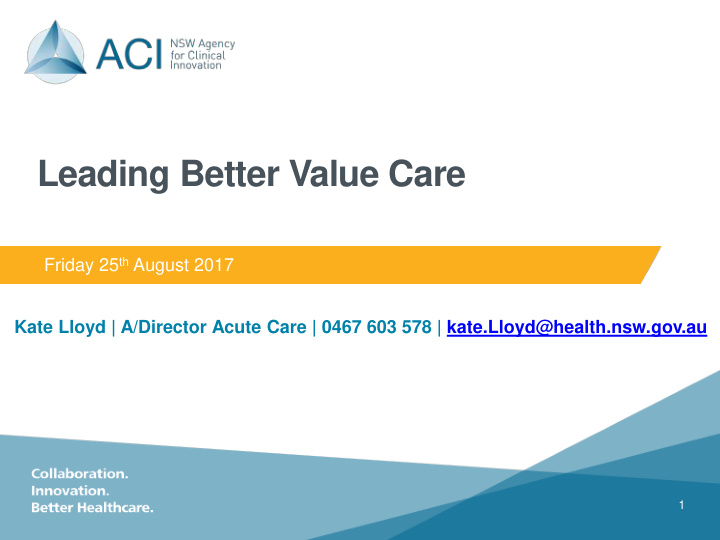



Leading Better Value Care Friday 25 th August 2017 Kate Lloyd | A/Director Acute Care | 0467 603 578 | kate.Lloyd@health.nsw.gov.au 1
Acknowledgement The ACI acknowledges the traditional owners of the land on which we meet. We pay our respects to Elders past and present and extend that respect to other Aboriginal peoples present here today.
Leading Better Value Care 1. Management of Osteoarthritis (ACI) 2. Osteoporotic Refracture Prevention (ACI) Musculoskeletal service (ACI) 3. (Diabetes) High Risk Foot Services (ACI) 4. Inpatient Management of Diabetes Mellitus (ACI) 5. Renal Supportive Care (ACI) 6. Inpatient management of Chronic Heart Failure (ACI) 7. Inpatient management of Chronic Obstructive Pulmonary Disease (ACI) 8. Falls in Hospitals (CEC) 3
Leading Better Value Care 1. Management of Osteoarthritis (ACI) 2. Osteoporotic Refracture Prevention (ACI) Musculoskeletal service (ACI) 3. (Diabetes) High Risk Foot Services (ACI) 4. Inpatient management of Diabetes Mellitus (ACI) 5. Renal Supportive Care (ACI) 6. Inpatient management of Chronic Heart Failure (ACI) 7. Inpatient management of Chronic Obstructive Pulmonary Disease (ACI) 8. Falls in Hospitals (CEC) 4
Unwarranted Clinical Variation ' variation that cannot be explained by the condition or the preference of the patient; it is variation that can only be explained by differences in health system performance ' 5
Unwarranted Clinical Variation Chronic Obstructive Airway Chronic Heart Failure (CHF) Disease (COPD) Guidelines for the prevention, COPD-X (2017) detection and management of chronic heart failure in Australia (2011) NSW Clinical Service Framework for CHF (2016) TSANZ – Oxygen guidelines for acute oxygen use in adults (2015) Quality Use of Medicines Indicators for Australian Hospitals (2014) 6
• Service utilisation data • Audit tool (administrative dataset) • Implementation of • Clinical guidelines improvement plan • Bureau of Health • Expert Reference Information (BHI) • Benchmarking Group • Healthcare in Focus • NSW care bundle (mortality and readmission) • Admitted patient data survey • Partnership audit (N=40) • Local data • Feedback session 7 • Improvement plan Source: Storyboard That
8
Support and Tools Pre-planning pack / checklist Audit tools (COPD, CHF) Auditors (partnership audit) Patient reported measures experience (linked to BHI) outcomes (PROMIS-29 + exploring disease specific) Data analysis (triangulation) Feedback session Tailored implementation support - QuIC 9
(Unwarranted) Clinical Variation in ED Admission routes 10
(Unwarranted) Clinical Variation in ED Time in ED 11
(Unwarranted) Clinical Variation in ED 12
(Unwarranted) Clinical Variation in ED 13
(Unwarranted) Clinical Variation in ED 14
(Unwarranted) Clinical Variation in ED 15
Lessons Learned So Far Sites require tailored support Some common themes: oxygen use and prescription spirometery testing timing of CXR’s smoking cessation support antibiotic use key referrals discharge practices Also provides an opportunity to showcase what sites are doing well 16
Level 4, Sage Building T + 61 2 9464 4666 67 Albert Avenue, Chatswood NSW 2067 F + 61 2 9464 4728 PO Box 699 info@aci.health.nsw.gov.au Chatswood NSW 2057 www.aci.health.nsw.gov.au Kate Lloyd A/Director, Acute Care (02) 9464 4602 | 0467 603 578 Kate.Lloyd@health.nsw.gov.au 17
CHF: CH F: NS NSW W Inpati atient C t Car are B Bundle Level 4, Sage Building T + 61 2 9464 4666 67 Albert Avenue, Chatswood NSW 2067 F + 61 2 9464 4728 PO Box 699 info@aci.health.nsw.gov.au INVESTIGATIONS INDICATOR Chatswood NSW 2057 www.aci.health.nsw.gov.au • Review of history Investigations performed? ECG • In what time frame? • Chest x-ray • Blood biochemistry Are actions taken in response to • Accurate assessment of fluid balance test results? SYMPTOM MANAGEMENT INDICATOR • Identification of cause of exacerbation Pulmonary congestion and load on the Evidence in the clinical notes of • Evidence-based medicines heart: administration of: best practice, including medicines • Dyspnoea • loop diuretics management Oxygen therapy • vasodilators o Non-invasive ventilation, where • inotropic agents o appropriate PATIENT FLOW, DISCHARGE AND CEILING OF CARE INDICATOR • Access to specialist support and allied health Evidence of : • key referrals • Access to advance care planning and palliative care services • appropriate transfer and • Access to disease management services discharge • medicines on discharge best • Provision of individualised management plans practice • Appropriate medicines management on discharge • community support services arranged in hospital 18
CO COPD: NS NSW W Inpati atient C Car are B Bundle Level 4, Sage Building T + 61 2 9464 4666 67 Albert Avenue, Chatswood NSW 2067 F + 61 2 9464 4728 PO Box 699 info@aci.health.nsw.gov.au CONFIRM (DIAGNOSIS), EXACERBATION AND SEVERITY Chatswood NSW 2057 INDICATOR www.aci.health.nsw.gov.au • Focused review of history and physical examination Investigations performed? • Spirometry unless the patient is confused or comatose In what time frame? • Arterial blood gas measurements for appropriate patients Are actions taken in response to • Chest X-ray and ECG test results? OPTIMISE TREATMENT INDICATOR Oral corticosteroids – IV corticosteroids show no additional benefit Timing of administration Antibiotics – for patients with clinical signs consistent with bacterial infection Type and timing Controlled oxygen therapy Compliance with TSANZ oxygen prescription guidelines PATIENT FLOW, DISCHARGE AND CEILING OF CARE INDICATOR • Access to allied and specialist services in hospital including nutritional support Key referrals and smoking cessation services. Access to pulmonary rehabilitation services • Ceiling of care discussions and access to palliative care services Evidence of advanced care directives and acute resuscitation plans 19
Recommend
More recommend